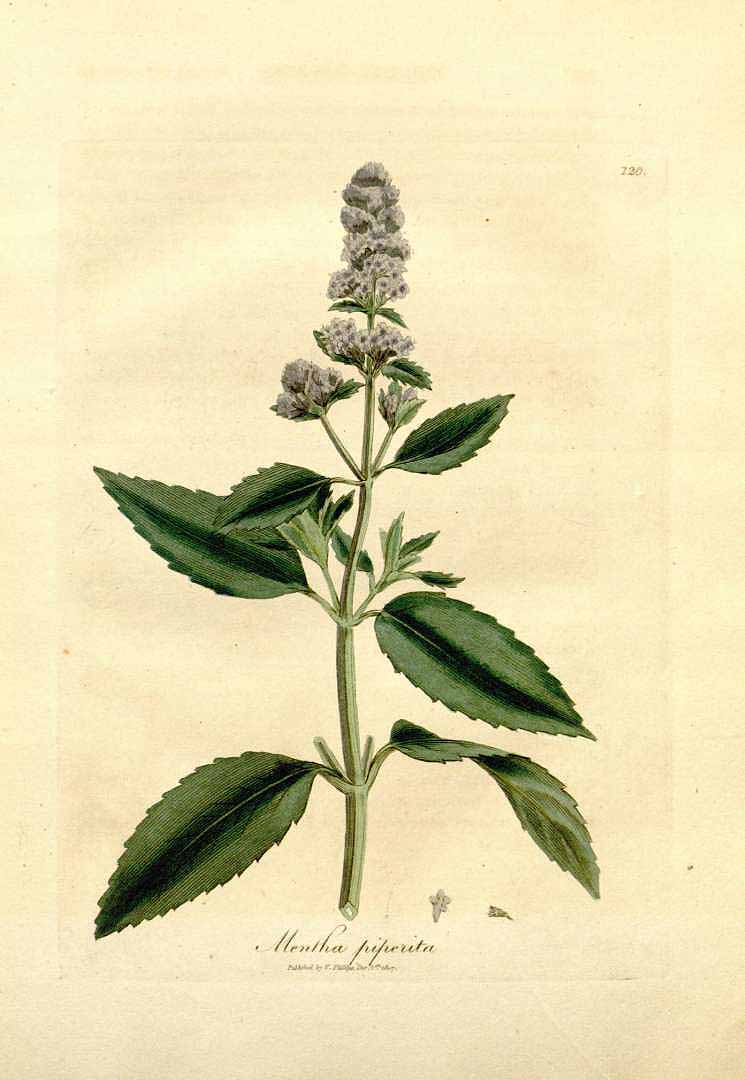 Also known as: Black Peppermint, Herba Menthae, Lamb Mint, Mentha Piperita.
Also known as: Black Peppermint, Herba Menthae, Lamb Mint, Mentha Piperita.
Scientific name: Mentha piperita.
Botanical family: Lamiaceae/Labiatae.
Part used: Leaves and stems.
Traditional use.
Peppermint is used for the common cold, cough, inflammation of the mouth and throat, sinusitis, runny nose, fever, liver and gallbladder complaints, irritable bowel syndrome, cramps of the upper gastrointestinal tract and bile ducts, dyspepsia, fever, flatulence, and for tension headache. It is also used for nausea, vomiting, morning sickness, respiratory infections, painful periods, diarrhea, small intestinal bacterial overgrowth, and as a stimulant.
Inhaled peppermint oil is used for symptomatic treatment of cough and colds.
Peppermint oil is used directly on the skin as an analgesic for pain.
Peppermint is a common flavoring agent in foods and beverages.
Peppermint oil is used as a fragrance component in soaps and cosmetics, and as a flavoring agent in pharmaceuticals.
Safety.
There are no concerns regarding safety when used in amounts commonly found in foods. Peppermint has Generally Recognized as Safe (GRAS) status in the US.1
There are no concerns regarding safety when used in medicinal amounts in children 8 years of age and older.
Traditionally catmint is used for children as it is less stimulant than peppermint e.g. Dr Clare’s Childrens Tea Blend.
Pregnancy: No concerns regarding safety when used orally in amounts commonly found in foods. Peppermint has Generally Recognized as Safe (GRAS) status in the US.1
Breastfeeding: as for pregnancy.
Constituents.
Essential oils, containing menthol, menthone and menthyl acetate. Trace constituents include alpha-pinene, sabinene, terpinolene, ocimene, gamma-terpinene, fenchene, alpha- and beta-thujone, citronellol, and other compounds.2,3
Flavonoids; rutin, menthoside, luteolinand rutinosides
Phenolic acids and lactones; rosmarinic acid, and others.
Miscellaneous; azulenes, choline, carotenes etc
Scientific evidence.
No clinical studies have been done.
Mechanism of action.
Activity is primarily, but not exclusively, due to the actions of the essential oils, from which a direct action on smooth muscle organs cause a stronger anti-spasmodic effect than some of its individual components. The antispasmodic effect has been confirmed on the small intestines of guinea pigs.8
Peppermint tea brings about a considerable increases in the production of bile. This activity has been confirmed in animal experiments with dogs. 9
The antispasmodic effect of peppermint oil is used internally for irritable bowel syndrome4 e.g. the medication colpermin which is derived from peppermint oil. This appears to result from direct relaxing effects on the gastrointestinal tract smooth muscle, characteristic of calcium antagonist action. Be careful with the oral use of any essential oils as they have very powerful effects. The oils have very concentrated constituents. Seek professional advice.
For pain in myalgias (muscle pain) and neuralgias (nerve pain), menthol in topical peppermint oil is thought to have a direct inhibitory effect on the sensitized pain receptors. Menthol might also act on the central nervous system to alter pain perception.5
Preliminary research suggests that luteolin-7-O-rutinoside from peppermint leaf can inhibit histamine release.2 Laboratory models of allergic rhinitis (runny nose) suggest that peppermint leaf extract might relieve nasal symptoms.6
A mild sedative action has been confirmed in animal experiments in mice.10
Adverse Reactions:
Topically; peppermint oil can cause skin irritation and contact dermatitis.5 Always patch test on normal skin before use.
Contact sensitivity in the mouth has been reported.7
Interactions with herbs and supplements.
None known.
Interactions with Drugs.
avoid internal use of peppermint oil with Cyclosporine (Neoral, Sandimmune), which is an immune suppressant:
None known.
Dosage.
Recommended dose: 2-7mls per day 1:5 tincture 30% alcohol.
Infusion: range from 3-6 tsps. per day.
Powder/capsule: range from 2-4 gms per day.
Liquid extract: 2-4ml/day.
Dr Clare’s Joint Cleansing Tea provides ½ tsp. per day of peppermint.
References.
1. FDA. Center for Food Safety and Applied Nutrition, Office of Premarket Approval, EAFUS: A food additive database. Available at: vm.cfsan.fda.gov/~dms/eafus.html.
2. Inoue T, Sugimoto Y, Masuda H, Kamei C. Antiallergic effect of flavonoid glycosides obtained from Mentha piperita L. Biol Pharm Bull 2002;25:256-9.
3. Nair B. Final report on the safety assessment of Mentha Piperita (Peppermint) Oil, Mentha Piperita (Peppermint) Leaf Extract, Mentha Piperita (Peppermint) Leaf, and Mentha Piperita (Peppermint) Leaf Water. Int J Toxicol 2001;20:61-73.
4. Storr M, Sibaev A, Weiser D, et al. Herbal extracts modulate the amplitude and frequency of slow waves in circular smooth muscle of mouse small intestine. Digestion 2004;70:257-63
5. Davies SJ, Harding LM, Baranowski AP. A novel treatment of postherpetic neuralgia using peppermint oil.
Clin J Pain 2002;18:200-2.
6. Inoue T, Sugimoto Y, Masuda H, Kamei C. Effects of peppermint (Mentha piperita L.) extracts on experimental allergic rhinitis in rats. Biol Pharm Bull 2001;24:92-5.
7. Morton CA, Garioch J, Todd P, et al. Contact sensitivity to menthol and peppermint in patients with intra-oral symptoms. Contact Dermatitis 1995;32:281-4.
8. Forster HB, Niklas H, Lutz S. Planta Med 40, 309-319 (1980).
9. Della Loggia R, Tibaro A, Lunder TL. Fitoterapia 61, 215-221 (1990).
10. Miething H, Holz W. Pharm. Ztg. 133. 16-17. (1988)